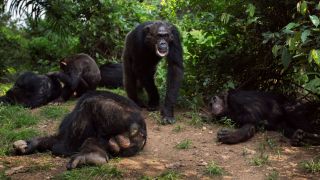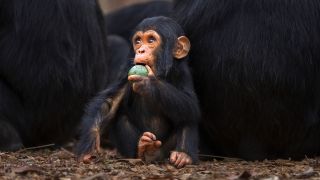Chimpanzees: Intelligent, social and violent
Chimpanzees share many human traits but are fiercely unique.

Chimpanzees (Pan troglodytes), also known as chimps, are one of our closest living relatives and members of the great ape family, along with gorillas, orangutans, bonobos and humans. Chimps share 98.7% of their DNA with humans and have a lot of the same traits. They are known for being intelligent, social and violent animals that live in complex societies. Chimpanzees have suffered greatly from the increasing presence and influence of modern humans in their environment and are now threatened with extinction.
How big is a chimpanzee?
Chimpanzees are between 3 feet 3 inches and 5 feet 6 inches (1 to 1.7 meters) tall when standing upright like a human. However, they mostly walk on all fours using their knuckles and feet. Males are slightly bigger than females. A male can weigh up to about 154 lbs. (70 kilograms) in the wild, compared with a maximum weight of about 110 lbs. (50 kg) for a female, according to the University of Michigan's Animal Diversity Web (ADW).
Size: Up to 5 feet 6 inches (1.7 meters) standing
Life span: Up to about 50 years
Conservation status: Endangered
Chimps are stronger than humans, despite being smaller. In fact, they are about 1.35 times more powerful than humans as they have more fast-twitch muscle fibers, which are good for strength and speed, Live Science reported. These fast-twitch muscle fibers enable chimps to outperform people in tasks such as pulling and jumping. Humans evolved to have more slow-twitch muscle fibers that are better for endurance and traveling long distances.
Related: Building blocks of language evolved before humans split from chimps and monkeys
What do chimpanzees eat?
Chimpanzees mainly eat fruit and leaves. However, their diet varies depending on where they live and the seasonal availability of food. Chimps are omnivores, like humans, so they will also eat some meat. Their diet includes insects and mammals, such as monkeys and bushbuck antelope, according to the Jane Goodall Institute UK.
Related: Chimps seen sucking brains from monkeys' heads
Chimpanzees are highly intelligent animals and use various methods to find their food. They have been observed using more tools than any other animal on the planet except for humans. Their use of tools includes holding rocks to hammer open nuts, stripping leaves off twigs to gather termites from inside termite mounds and crushing leaves to use as sponges for cleaning themselves, according to ADW.
Do chimpanzees attack people?

Wild chimpanzees are usually fearful of humans and will keep their distance. However, there have been recorded incidents of chimpanzees attacking and killing people. This usually happens when humans move into and destroy chimpanzee habitats, reducing their access to food. Chimpanzees may then take to stealing unprotected human food, such as crops, and in the process become more confident around humans.
Chimpanzees have attacked more than 20 people in the Western Region of Uganda over the past 20 years and killed at least three human infants since 2014, National Geographic reported in 2019. Chimpanzees typically direct their aggressive and sometimes predatory behavior toward children because the animals are more fearful of larger human adults, especially men, according to National Geographic. Chimps have also snatched and killed human babies. Most of the time these are isolated and seemingly reckless attacks by individual chimps, but one chimpanzee in the 1990s killed seven children before he was killed by humans, National Geographic reported.
Captive or pet chimpanzees attack people far more often than their wild kin, because they can lose their fear of people altogether. During attacks, chimps will target a person's face, hands, feet and genitals. The Jane Goodall Institute UK noted that pet chimpanzees are destructive and too dangerous to be kept as part of the family, and that it is difficult to keep them stimulated and satisfied in a human environment.
Chimpanzee society

Chimpanzees are highly social animals and live in communities of between 10 and 180 individuals, according to the Max Planck Institute for Evolutionary Anthropology in Germany. They live in fusion-fission societies where the community breaks up into small subgroups (fission) that travel separately and sometimes come together (fusion).
Males will stay in their birth community, while females can move into neighboring communities once they are old enough to breed. Male chimpanzees defend their community's territory against neighboring chimp communities and will kill members of other groups. Chimpanzees are the only species other than humans to carry out coordinated attacks on each other, Live Science previously reported. This warlike behavior, documented by famed primatologist Jane Goodall, among others, challenged the notion that warfare is a development of modern humans.
Related: Chimps are naturally violent, study suggests
Male and female chimpanzees mate with multiple partners throughout the year. Mating occurs more frequently than required for breeding purposes and serves social functions as well, such as developing bonds between individuals, according to ADW. Males may sometimes secure exclusive access to females for reproduction by preventing other males from mating with the female, although females also have some mate choice. Much variation has been observed in all aspects of chimpanzee social structure and reproductive strategies, according to the Max Planck Institute for Evolutionary Anthropology.
A chimpanzee gestation period lasts about 230 days or almost 33 weeks, according to the International Union for Conservation of Nature (IUCN). Females give birth to a single baby chimpanzee or occasionally twins. A baby chimpanzee is about 4.5 lbs. (2 kg) at birth and is carried around clinging to its mother's abdomen, according to ADW. As they grow up, infants begin to walk on their own but continue to hitch a ride on their mothers, increasingly on her back, until they are weaned at about 4 to 5 years old. Chimpanzees typically live up to about 50 years in the wild, according to the IUCN. They can survive longer in captivity, where one female lived into her 70s.
Where do chimpanzees live?
Chimpanzees live in forests across the African continent and can be found from southern Senegal in West Africa to western Tanzania in East Africa, according to the IUCN. However, they have a discontinuous distribution, which means populations can be separated by great distances. Chimps are mainly associated with tropical rainforests, but they occupy a variety of different habitats, including swamp forests and savannas. They also live at varying elevations and can be found in forests on mountains up to 9,000 feet (2,750 m) above sea level, according to ADW.
Kingdom: Animalia
Phylum: Chordata
Class: Mammalia
Order: Primates
Family: Hominidae
Genus: Pan
Species: troglodytes
The chimpanzee species (Pan troglodytes) is split into four subspecies, according to the Integrated Taxonomic Information System (ITIS): Nigeria-Cameroon chimpanzees (Pan t. ellioti) live in a small range around the border of Nigeria and Cameroon; eastern chimpanzees (Pan t. schweinfurthii) are found from the central African Republic and Democratic Republic of Congo in Central Africa to western Tanzania, with members farther north in Uganda, and a small population in South Sudan; central chimpanzees (Pan t. troglodytes) range from Cameroon to the Democratic Republic of Congo; and finally, western chimpanzees (Pan t. verus) live between Senegal and Ghana, according to the IUCN.
Are chimpanzees endangered?
Chimpanzees are considered an endangered species and at risk of becoming extinct. Their population is declining and there are estimated to be fewer than 300,000 chimpanzees left in the wild, according to the IUCN. The major threats to chimpanzees are poaching, habitat loss and degradation, and disease.
Poaching is the biggest threat to most chimpanzee populations, even though killing great apes is illegal. Poachers will hunt chimpanzees for food, either to eat themselves or to supply the demand for bushmeat in urban markets. Often chimpanzees are not targeted specifically but are taken by hunters when an opportunity presents itself, such as when they get caught in a hunter's snare. Infant chimpanzees may also be taken to be sold as illegal pets. Humans also sometimes kill chimpanzees to stop them from raiding their crops.
Forests have, and continue to be, converted to farmland across Africa, which reduces the available habitat for chimpanzees. In addition, logging, mining, oil extraction and the building of roads alter and destroy chimpanzee habitat and have a negative impact on their survival. Chimpanzee populations are also declining due to the Ebola virus and other diseases that cross between humans and chimpanzees.
Related: How NASA's satellite data could help protect chimps
Famous chimpanzees

Chimpanzees have a long history of being used in human experiments. For example, chimps were among the animals that helped pave the way for human space travel. The U.S. sent two chimpanzees named Ham and Enos into space in the early 1960s, effectively used as living test dummies to better understand how the human body would cope with such a trip. Ham became the first chimp in space in 1961, according to NASA. Enos became the second chimp in space in November later the same year, although this was after the Soviet Union and the U.S. had successfully sent humans into space, according to Live' Science sister site Space.com.
Chimps are also used in entertainment, such as circuses, commercials and movies. A performing ape named Oliver became famous for his human-like appearance, including a bald head and a tendency to walk upright. He was promoted as a missing link between humans and chimps, or as a humanzee — the theoretical hybrid pairing between a chimp and human. A 1998 study into Oliver's chromosomes and DNA, published in the American Journal of Physical Anthropology, revealed he was actually just a regular chimpanzee. Other bald chimpanzees have captured the public's attention. A video of a completely hairless chimp named Mongo at Twycross Zoo in the U.K. went viral in 2016, according to BBC News. Mongo's unusual appearance was due to alopecia, a condition inherited from his father.
Related: Chimpanzees are not legal persons, court rules
A pet chimpanzee named Travis, who was used in television commercials, made headlines in 2009 when he savagely attacked a woman in the street in Stamford, Connecticut. The male chimp caused the woman life-threatening injuries by ripping at her face, neck and hands during a lengthy attack, according to CNN. Travis was later fatally shot by police.
Additional resources
Sign up for the Live Science daily newsletter now
Get the world’s most fascinating discoveries delivered straight to your inbox.

Patrick Pester is a freelance writer and previously a staff writer at Live Science. His background is in wildlife conservation and he has worked with endangered species around the world. Patrick holds a master's degree in international journalism from Cardiff University in the U.K.
